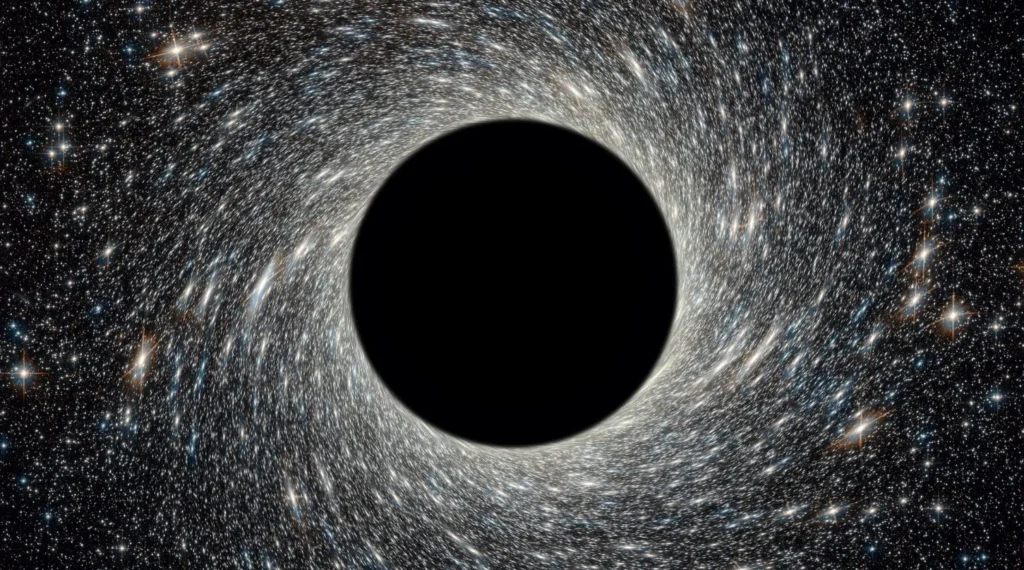A group of scientists has measured the heaviest pair of supermassive black holes yet discovered using archival data from the Gemini North telescope. Although it has never been seen, the merger of two supermassive black holes is an event that has long been predicted. This huge pair provides hints as to why in the cosmos such an occurrence is so implausible.
A supermassive black hole can be found at the heart of almost every large galaxy. Black holes in two merging galaxies may form a binary pair, which indicates that they are in a bound orbit around one another. Though this has never been seen, it is theoretically predicted that these binaries would ultimately merge. Astronomers have debated this issue for decades, wondering whether such an occurrence is feasible.
Astronomers have put new light on this issue in an article that was just published in The Astrophysical Journal.
The group examined a supermassive black hole binary inside the elliptical galaxy B2 0402+379 using data from the Gemini North telescope in Hawaii, which is one part of the International Gemini Observatory run by NSF’s NOIRLab. At just 24 light-years, this supermassive black hole binary is the shortest separation ever directly measured and is the first supermassive black hole binary ever resolved in sufficient clarity to view both objects independently. Further investigation showed that the pair had been stuck at this distance for more than three billion years, raising the question, “What’s the holdup?” Even though this tight separation portends a strong union.
The scientists used archival data from Gemini North’s Gemini Multi-Object Spectrograph (GMOS) to measure the speed of stars around the black holes to gain a better understanding of the dynamics of this system and its aborted merger.
Professor of physics at Stanford University and co-author of the publication Roger Romani remarked, “We were able to map the stars’ increasing velocities as one looks closer to the galaxy’s center thanks to the excellent sensitivity of GMOS.” “With that, we were able to infer the total mass of the black holes residing there.”
The duo is the heaviest binary black hole ever recorded by the researchers, with an estimated mass of 28 billion times that of the sun. This measurement not only provides important background information on the history of the host galaxy and the binary system’s development, but it also lends credence to the long-held hypothesis that the mass of a supermassive binary black hole is a major factor in delaying a possible merger.
According to Martin Still, the NSF program director for the International Gemini Observatory, “the data archive serving the International Gemini Observatory holds a gold mine of untapped scientific discovery.” “Mass measurements for this extreme supermassive binary black hole are an awe-inspiring example of the potential impact from new research that explores that rich archive.”
Predicting the formation process of this binary can aid in determining when and if it will combine; several hints suggest that the pair developed as a result of numerous galaxy mergers. First, B2 0402+379 is a “fossil cluster,” which means that its stars and gas came from the merger of a whole galaxy cluster into one huge galaxy. Furthermore, the fact that there are two supermassive black holes and their immense combined mass indicates that they were formed by the merger of several smaller black holes from other galaxies.
Supermassive black holes do not meet head-on after a galactic merger. Rather, they settle into a bound orbit and start slingshotting past each other. Energy is delivered from the black holes to the nearby stars with each pass. The two are drawn closer together as their energy levels drop until they are just light-years away, at which point gravitational radiation takes control and they merge. This process has never been directly witnessed in a supermassive binary, however, it has been in pairings of stellar-mass black holes (the first known incidence was in 2015 when gravitational waves were detected).
The researchers concluded that an extraordinarily high number of stars would have been required to slow the binary’s orbit sufficiently to get them thus close, given their newfound understanding of the system’s extraordinarily massive mass. The black holes appear to have expended almost all of the material in their neighborhood during this process, starving the galaxy’s core of gas and stars. The pair’s union has reached a standstill because there is no longer any material available to slow down their orbit further.
“Normally it seems that galaxies with lighter black hole pairs have enough stars and mass to drive the two together quickly,” Romani stated. “It took a lot of stars and gas to finish these pair since they are so hefty. However, the core galaxy has been cleared of such material by the binary, making it stationary and available for our investigation.”
It remains to be seen whether the two will break out of their stalemate and unite on timeframes of millions of years, or whether they will stay in orbital limbo indefinitely. The gravitational waves that follow from their merging would be 100 million times stronger than those that arise from mergers of stellar-mass black holes.
The two could be able to bridge that last gap through a third black hole or another galaxy merger that would add more mass to the system and lower the pair’s orbit down to the point where they might combine. As a fossil cluster, B2 0402+379 is unlikely to be the result of another galactic merger.
Also Read:
Lead author and Stanford freshman Tirth Surti said, “We’re excited about follow-up investigations of B2 0402+379’s core where we’ll look at how much gas is present.” “This should give us more insight into whether the supermassive black holes can eventually merge or if they will stay stranded as a binary.”


